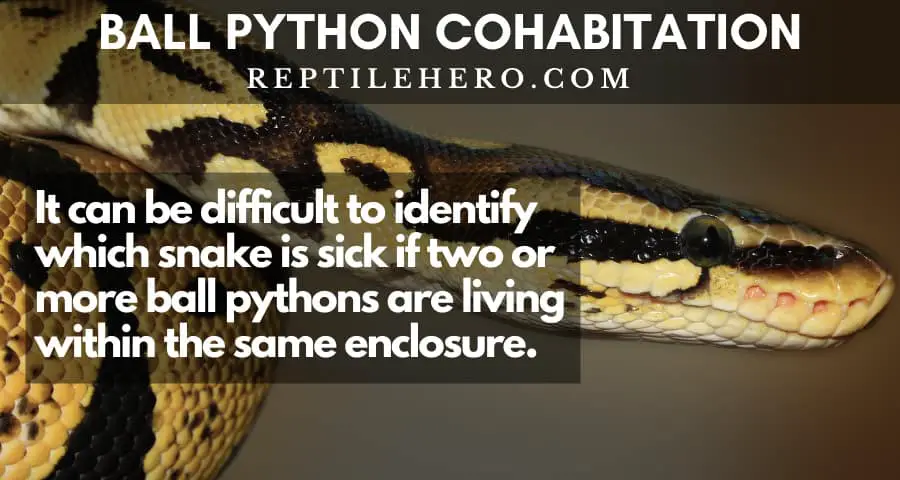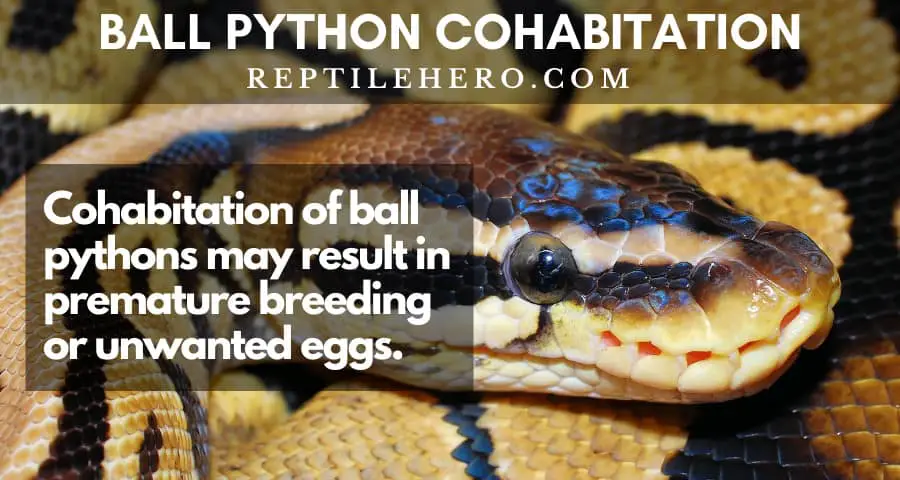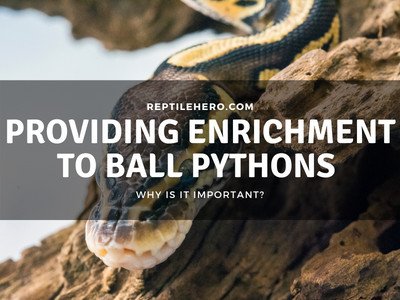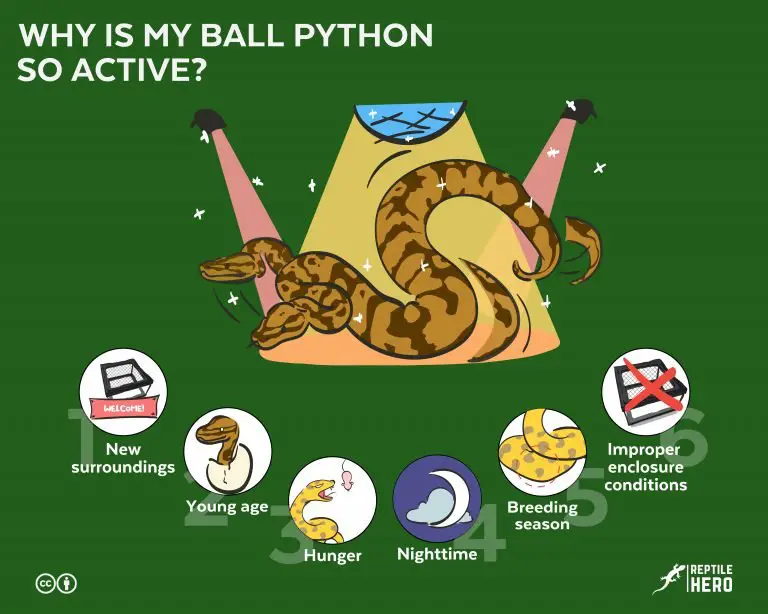Can Two Ball Pythons Live Together? (Be Careful)
When I got my first two ball pythons, I was wondering if they could be kept together in one tank. Cohabitation can be appealing, especially to those who are new to ball python keeping but is it okay?
Two ball pythons should be allowed to live together only for pairing purposes that usually last from four hours up to two days. Cohabitation of ball pythons should be avoided in all other cases. Two or more ball pythons should never cohabit because of:
- Stress
- Disease Spreading
- Illness Problem Identification
- Premature Breeding
- Unwanted Eggs
- Competition for Resources
- Aggressive Behavior and Cannibalism
Read on to find out why cohabitation is not a good idea, where this idea comes from, and other things about the cohabitation of ball pythons.

1. Stress
Two ball pythons should not live together as this can cause stress leading to lack of appetite, weight loss, tight coiling when being handled, nose-rubbing against objects inside the enclosure, and defensiveness.
Ball pythons can be stressed because of: shared enclosure, over-handling, poor husbandry, underfed, etc.
A stressed ball python might go off-feed. Because of refusing food, your snake’s immune system may drop and become susceptible to different diseases such as mouth rot, respiratory infection, etc.
2. Disease Spreading
One of the risks of having a communal setup of ball pythons is the spread of diseases. One ill ball python can lead to all python in the tank suffering from the same disease.
One of the risks of having a communal setup is contagion as most snake diseases are contagious such as respiratory infection. If one of the ball pythons becomes ill, the other snake is also at risk.
We all want our snakes to be healthy. But cohabiting ball pythons may lead to unnecessary trips to the vet, not to mention the fees that are associated with these visits.
3. Illness Problem Identification
It can be difficult to determine which ball python is suffering from fecal abnormalities or other residue left inside the tank because it is unclear which snake produced them in the first place.
If you are a python parent like myself, you know very well that poop is known, not only to snakes but also to other animals, as one of the indicators of health status. In a communal setup, it can be hard to tell which ball python has an unhealthy stool.

Sometimes, the vet requires a stool sample from a sick ball python. Having two or more ball pythons in one tank makes it hard to identify which one is sick and requires medical attention. Unless you have enough money to shoulder the costs, you can bring all your snakes to the clinic.
Another example is when a ball python regurgitates. Identifying which snake regurgitates might be difficult when they are sharing the same enclosure. To be honest, I can’t envision myself in this perplexing situation.
4. Premature Breeding
Premature breeding of ball pythons may occur if a young female is cohabiting with a male python. This is dangerous as it can cause serious problems such as egg-binding.
Just like in humans, early pregnancy may occur in ball pythons, and this occurrence may lead to complications.
The sexual maturity of a female ball python ranges from 27 to 31 months, while the male ranges from 16 to 18 months.
Aside from age, ball pythons’ weight plays a huge role in safe, healthy, and successful breeding. Many breeders have different opinions on how much a female should weigh before mating. But for the safety of my ball pythons, I waited until my females weighed exactly 1800 grams and my males reached 800 grams.
Proteins, fats, lipids, and other compounds stored in the female ball python’s body will be used in forming eggs. She may become weak as a result of this. Think about what would happen if a small, premature ball python experienced all of this, as well as the actual laying of eggs.

5. Unwanted Eggs
If two mature ball pythons of opposite genders are kept together, it may result in unwanted eggs.
As per my own experience, male ball pythons tend to skip meals and are more focused on breeding. So, there is a huge possibility that you may end up with unwanted eggs from cohabiting ball pythons.
Taking care of a gravid ball python and its incoming eggs is different from the basic husbandry of our beloved snakes.
Cohabitation of Ball Pythons with Same Gender
Can we put two female ball pythons together? How about two male ball pythons in one tank?
Two female ball pythons are unlikely to fight in the same way as males do. However, ball pythons are not social creatures. Because they don’t feel safe with another python in their territory, one or both of them may go off-feed.
Two male ball pythons, if forced to cohabit, may fight each other, especially during the breeding season, which may result in one or both snakes being injured or, in the worst-case scenario, killed.
During the breeding season, the male reproductive instinct activates. Some breeders put two males together to kick-start this instinct in some passive male ball pythons. A male ball python is considered passive if it doesn’t show interest in mating during the breeding season.
6. Competition for Cool and Hot Space
Two ball pythons, whether of the same size or not, may end up competing for specific areas inside the tank (like the cold and hot spots).
Regardless of whether they are the same size or not, they will fight inside the shared enclosure for different resources such as ideal spots for cooling and warming, and their hides.
I’ve seen this. One time, I let out my ball pythons for a quick clean of their enclosures. I put them together in a tub (70-liter storage box) and guess what, two of them were trying to flip each other without any of those resources I mentioned above!
7. Aggressive Behavior and Cannibalism
On rare occasions, ball pythons may attack each other aggressively with the intent of eating each other.
Although it is rare, there was one case I encountered before where ball pythons were being transported for a show but ended up cannibalizing each other. Being transported or not, it seems to me that the underlying cause might be stress and poor husbandry.
Ball Python Cohabitation Allowed
The only case where ball pythons can cohabit is for breeding purposes. One male and one female ball python can cohabitate for up to 2 days, more is not advised.
When both pythons are intertwined and their tails coil around each other, this refers to ‘lock’. This locking behavior usually lasts from four hours up to two days and must not be disturbed. After locking, both snakes should be separated from each other so they can rest. Supervising the snakes during this time is important to prevent any unwanted situation from happening.
The 3 Wrong Reasons to Cohabit Ball Pythons
Why do people want to cohabit their snakes?
The wrong reasons why people cohabitate ball pythons are 1) lack of experience 2) lack of resources and attempt to save money 3) the myth of the ball pythons’ past condition.
1. Newcomer to the Hobby
The thought of keeping two or more ball pythons together in an enclosure is common for newcomers to the hobby.
Starters often ask the question, and there’s nothing wrong with asking about cohabitation. We’ve been there. It is a good thing to ask first before doing anything.
It is highly recommended to do your research about the species of snake you are getting before bringing one (or more) home.
2. Lack of Resources, Saving Money and Space
People may cohabitate ball pythons due to lack of resources, mainly enclosure itself. They also want to save space, time, energy, and money while keeping ball pythons.
I’ve seen it many times. They were asking about cohabiting their ball pythons for several days because the enclosure they ordered had not been delivered yet.
Taking care of ball pythons requires us to have enough space to put the enclosures in. One may ask about cohabiting ball pythons due to limited space.
Cleaning several enclosures, feeding each snake one by one, changing the enclosure’s bedding (if needed), etc. takes an ample amount of time and energy. People may want to consider cohabiting to save time and energy.
Another reason is money. Knowing the cost of resources for ball python keeping, one may ask about cohabiting to save money.
Before getting ball pythons, it is critical to prepare their habitat first and foremost. This includes enclosures, hides, heating, and cooling spots, the right parameters, drinking bowls, bedding, etc. The hobby of keeping ball pythons requires effort, time, space, money, and importantly, care.
3. The Myth of “Ball pythons’ Past Conditions”
Cohabitation of ball pythons may occur when former owners tell keepers-to-be that their ball pythons have been living in pairs for quite some time.
People often encounter a situation where the owner of the ball pythons they want to buy from tells them that their snakes have been living together for several years. Good thing is that they don’t settle for this information and ask other experienced keepers about the situation.
Having the right information about the pet is vital before getting one. That is why I can’t stress this enough, it is important to research thoroughly everything about the pet (in our case, ball pythons) that we are planning to take care of.
Wild Ball Pythons – Do They Cohabitate?
Female ball pythons in the wild only incubate their eggs but do not take care of the hatchlings. [1][2]
Wild ball python hatchlings indeed tend to live within the same area where they were hatched but this is only until they learn how to hunt for food, after which they tend to find a new hide and live on their own. [1]
Wild adult ball pythons do not cohabitate in general but they gather for breeding purposes. Female ball pythons are often found alone in their den together with their egg clutch. [1]
Summary of Ball Python Cohabitation
- The cohabitation of ball pythons is not recommended. Cohabitation may result in ball pythons: being stressed; getting infected from other sick snakes; being confused from other sick ball pythons; being prematurely bred; having unwanted eggs; competing for ideal spots inside the enclosure; to aggressively attacking each other with the intent of killing.
- The reasons why people force ball python cohabitation are: being a newcomer to the hobby; saving money, space, and lack of resources; informed about ball pythons’ past conditions.
- Female ball pythons in the wild only incubate their eggs but do not take care of the hatchlings. Wild ball python hatchlings live within the same area where they were hatched but may live on their own after learning how to hunt for food. Wild adult ball pythons are often found with their egg clutch or alone but gather for breeding purposes.
Sources
[1]
https://doi.org/10.1046/j.1095-8312.2003.00169.x
[2]






